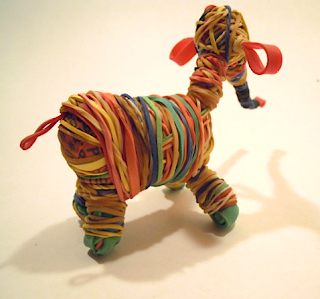When I was in a stationery store recently, I noticed that they still sell balls made up of rubber bands, and it occurred to me that it might be worth trying to create an elephant with rubber bands. I had absolutely no idea if it would work without wires or something to help shape it, but I figured it was worth a try.
I won't go into the history of rubber again, since I covered it in my post about eraser printing. Rubber bands, however, seem to have originated in England around 1845, when they were patented by Stephen Perry. Rubber bands are made by extruding rubber into a long tube that provides the general shape. The tube is then placed on a metal form known as a mandrel and cured with heat. Once cured, it is sliced across the width of the tube into bands of varying width.
Interestingly, rubber bands release heat when they are stretched—an effect you can apparently feel by holding it to your lips. By the same token, when the rubber band is released, it will absorb heat, causing the atmosphere around it to cool.
For today's elephant, I used all the rubber bands I could find in the house, which amounted to this pile.
I didn't realize I had animal-shaped rubber bands when I threw this pile together, but when I looked at the pile, I discovered that there were two of these sitting right on top. I didn't use them in today's elephant, but it was funny to find them there.
I started by balling up a heavy rubber band into a small, round shape.
Next, I wrapped a bunch of smaller rubber bands around this basic form.
I kept wrapping rubber bands around the basic shape I'd started, then added a couple of wide rubber bands as legs, tying them off with tiny rubber bands wrapped around four times.
I secured this whole little bundle around its circumference with another rubber band. This, I decided, would be the elephant's hindquarters.
I made a similar bundle for the front. I wasn't sure at this point how the body was going to work, but I thought I could probably just bind them together with another rubber band.
Next, I made the head. I formed the ears by wrapping a long, wide rubber band around the bundle I'd made for the head shape, then tied it off on each side with tiny rubber bands.
I used a similar idea to form the trunk. Once the trunk was on the head, I secured it with a few more rubber bands.
To secure the head to the body, I ran a couple of rubber bands over the forehead and down behind the front legs, then wrapped a rubber band around the admittedly floppy join to form a stronger neck.
The photo below shows the general shape I now had to work with, although I could see that I was going to at least have to lengthen the legs somehow.
Lengthening the legs was by far the most frustrating and difficult part of this whole thing. I wrapped wide rubber bands around the little feet I had, but it was incredibly hard to make them stay. Eventually, with enough tiny rubber bands wrapped around, they stayed on, but there has to be a better was to do this.
From here on, I mostly just wrapped rubber bands around the whole thing in various ways to shape the elephant, make it secure, and make it look a little neater. I forgot to photograph the stages along the way, but you can see that I wrapped a lot of rubber bands around the body from front to back, and around the mid-section.
The finishing touches were a little tail I tucked up under the rubber bands on the elephant's hindquarters, and a bunch of tiny rubber bands down the trunk to give it some shape. I left the ears as they were—mostly because I didn't know what else to do with them in the time I had.
It's not the tidiest thing I've ever made, but it worked out better than I thought it would. It took longer than I expected, at about two hours, mostly because of the trouble I had with the leg extensions.
I'm definitely not going into the rubber band animal business anytime soon, but I can live with this. It's also got entertainment value, because the rubber is so densely packed that it has a heck of a bounce when it falls on the floor.
Elephant Lore of the Day
Elephants seem to have a predilection for running amok in rubber plantations. This is partly because they like the leaves of palm and rubber trees, but also because the plantations have encroached significantly on existing elephant habitat.
In recent years, there have been increasing numbers of lethal encounters between elephants and humans on plantations across South and Southeast Asia. This occasionally results in humans being trampled to death, although it is more common for the elephants to be destroyed. One of the saddest victims of this uneasy relationship has been the Sumatran elephant, which just this week was placed on the critically endangered list—largely because it is no longer welcome across its former range.
To Support Elephant Welfare
World Wildlife Fund
World Society for the Protection of Animals
Elephant sanctuaries (this Wikipedia list allows you to click through to information on a number of sanctuaries around the world)
Performing Animal Welfare Society
Zoocheck
Bring the Elephant Home
African Wildlife Foundation
Elephants Without Borders
World Wildlife Fund
World Society for the Protection of Animals
Elephant sanctuaries (this Wikipedia list allows you to click through to information on a number of sanctuaries around the world)
Performing Animal Welfare Society
Zoocheck
Bring the Elephant Home
African Wildlife Foundation


















No comments:
Post a Comment